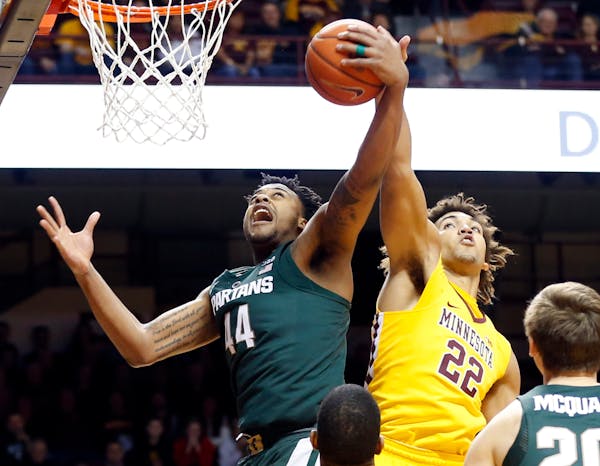Two days after Villanova won the national title over North Carolina on an unforgettable buzzer-beater last spring, Richard Pitino sat in his office wondering what to say. Frustrated Gophers basketball fans wanted him fired. Faithful supporters wondered about his program's direction, after an abysmal 8-23 season, worst in school history.
So he wrote a blog.
It was his first in six months; his most recent post had been on Amir Coffey signing that November. In the coach's new blog, Coffey went from subject to target audience. Pitino wrote of his vision for the 2016-17 season, trying to convince his soon-to-be freshman and everyone else reading online that this season would be different.
"We are a lot closer than people think," Pitino wrote on April 6, 2016. "We will break through very soon … It was just a few years ago Villanova endured a tough season, and look at them now."
Imagine social media's reaction to that line. Did Pitino mean his rock-bottom program would be competing for a national title in a few years?
Pitino just wanted people to think big.
"I said going into the season I thought it was going to be a huge turnaround, much like Villanova had," Pitino said, smiling behind his desk Tuesday. "I believed that."
Yet nobody expected a turnaround like this — not even the bold blogger himself.
The fourth-year Gophers coach was hoping to accomplish something like 'Nova did three years before the NCAA title, from 13-19 to 20-14 and the NCAA tournament. But this season has been more than "improved" — it has been borderline historic.
Minnesota (23-8, 11-7) is the most improved team in Division I, which helped Pitino win Big Ten Coach of the Year. One more victory would break a tie with the 2012 Indiana team and give Minnesota a Big Ten-record 16-win improvement. (Ohio State completed a 19-win turnaround in 1999, but those seasons were later vacated because of NCAA violations.)
Four key factors drove the Gophers' pending return to the NCAA tournament for the first time since 2013: handling a tougher schedule, new talent, defensive improvement and Pitino's re-recruitment of key players.
Going into Friday's Big Ten tournament quarterfinal game against Michigan State (19-13, 10-8) in Washington, D.C., the fourth-seeded Gophers have won eight of nine. After the bitterness of a 17-point loss at Wisconsin subsided, Pitino refocused his players this week toward the next goal.
"Could we win a championship? Yeah. We can beat anybody," Pitino said of the conference tournament. "The central focus is on putting yourself in a position to win a championship. That's never been done here before."
'Light-bulb game'
In Minnesota's second game, Pitino already believed the season he envisioned could become a reality, after the Gophers' 84-67 win against Texas-Arlington. The Mavericks, who upset Ohio State and Memphis last season, were the first of several early tests Pitino scheduled specifically to prepare his team.
Jordan Murphy had his first of 11 double-doubles and Reggie Lynch and Eric Curry scored in double figures, showing off the massive frontcourt upgrade. Minnesota had six players in double figures, including Coffey, Nate Mason and Dupree McBrayer. A fired up 34-year-old head coach told his players in the locker room, "Fellas, we can be good."
"I had a lot of respect for that team," Pitino said. "I thought that would be a great test for our guys. And we played terrifically. That was when the light bulb kind of went on."
Texas-Arlington, which beat Texas and St. Mary's and won the Sun Belt regular-season title, could be one of five Minnesota nonconference opponents playing in the NCAA tournament. Mount St. Mary's is the only team officially in the field for now, after winning the Northeast Conference tournament, but Florida State, Arkansas, Vanderbilt and UTA all were projected "in" as of Wednesday.
When the Gophers ended the nonconference season 12-1, they had a swagger to them, confidence that would be critical going into a Big Ten schedule ranked as the second-toughest in the league, according to stat analyst Ken Pomeroy.
"It just seemed to come together in the nonconference," Pitino said. "We've been as battle-tested as any team in the country."
New, much improved
Lynch was a wild card when practice began last fall. The 6-foot-10, 260-pound Edina native had been reinstated in September, after a summer suspension over a sexual misconduct case that did not result in charges, but he couldn't stay healthy. He spent more time rehabbing than practicing after shoulder and knee surgeries.
Coffey, the top recruit from Hopkins, was 6-8, but his slight frame was not ideal to handle physical Big Ten play. Another freshman, Curry, also was working to put on muscle and was an unknown commodity.
Pitino thought highly of senior graduate transfer Akeem Springs, but he wasn't sure if the former Milwaukee-Wisconsin wing was a starter after missing offseason workouts while in summer school.
The only newcomer with experience playing at the power-conference level was former Texas A&M forward Davonte Fitzgerald … and then he suffered a season-ending knee injury in October.
But these question marks quickly became strengths. Minnesota now gets 37 points per game from newcomers, which ranked near the top of the Big Ten.
Springs, the team's top three-point shooter, went from complaining about not starting early to becoming the emotional leader. Curry's rebounding and defense helped power the winning streak. Coffey, second on the team in scoring (12.0), assists (3.1) and minutes played (32.9), was selected to the All-Big Ten freshman team.
And Lynch, the biggest question mark of all? He led the conference in blocks and was named Big Ten Defensive Player of the Year.
"Reggie had never had experience in the Big Ten," Pitino said. "Akeem hadn't, Amir hadn't. [Eric Curry] hadn't. They played major minutes. To do all that with a new team was really, really exciting — and very, very rewarding."
Defensive resurgence
The Gophers were eyeing the NCAA tournament as early as late February, having bounced back from a five-game losing streak.
Mason said it was defense that got them out of the slump.
"The way we locked in on all the scouting reports, came out and defended and executed the game plan," he said. "It's rare for a young group like us. But you could tell in practice we were focused. And that's proud for me to say."
Last season, the Gophers defensive efficiency ranked 162nd in the country, second worst in the Big Ten. That rating jumped to 15th nationally and second in the conference this year, according to kenpom.com.
Length was a big part of the defensive resurgence — the long arms of Lynch, Murphy, Curry, McBrayer and others deflecting passes and shots — and Pitino, more confident in his half-court defense, scaled back the pressing.
The Gophers set a Big Ten record with 218 blocks (106 from Lynch), but they also went from allowing opponents to shoot 38.1 percent from three-point range to a Big Ten-best 30.8 percent, a school record.
"That's what kind of pushed Minnesota over the top this year," Big Ten Network analyst Shon Morris said. "Their ability to extend the defense."
Staying home
After a disastrous season, Mason, McBrayer and Murphy — three players critical to this season's run — were thinking about transferring.
Mason, McBrayer and former teammate Kevin Dorsey were suspended the last four games of 2016 following a sex video scandal. The video was posted to the social media accounts of Dorsey, who later transferred. Mason and McBrayer were punished for using poor judgment.
"I think the biggest thing with Nate and Dupree was we wanted to hold them accountable," Pitino said, "but we also wanted them to understand we had their back. We were [suspending them] to protect them."
Pitino had to convince McBrayer and Mason, and their parents, to stick with the program.
"They were supportive," Pitino said. "If we didn't have the parents who trusted in us, they would've transferred. I have an expression about my players and their families: 'Are you on my team or are you on your own team?' And Nate's and Dupree's parents were on our team throughout the whole thing. Fortunately for us, they believed that we were going to be better from it."
Murphy and his parents wanted to know if the culture was going to change. They didn't want to be a part of a program with problems. Gophers coaches had similar conversations with the families of Coffey and Michael Hurt.
"With everybody," Pitino said. "At the end of the season there was so much. For the returners and all those guys, to get them to believe, that's probably the most proud I am of any of this stuff."
So when Pitino finally sat down last April to blog, he couldn't help but have lofty goals. As crazy as it might have seemed then, the work had begun on the big turnaround.
"Talk is cheap," Pitino said. "I didn't have enough equity built up for people to believe me [then] — that makes sense. Fortunately, we were able to do it."
Ben Lively strikes out 6, Guardians top struggling Phillies 3-1 in key interleague showdown


